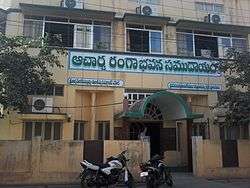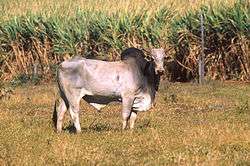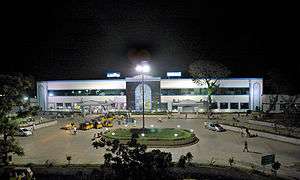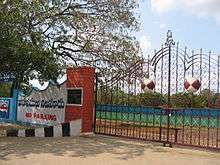Ongole
Ongole is a city in Prakasam district of the Indian state of Andhra Pradesh. It is the headquarters of Prakasam district and also the mandal headquarters of Ongole mandal in Ongole revenue division.[5][6] Ongole cattle, an indigenous breed of oxen, derived its name from Ongole.[7]
Ongole | |
|---|---|
.svg.png) Ongole Location in Andhra Pradesh, India | |
| Coordinates: 15.506°N 80.049°E | |
| Country | India |
| State | Andhra Pradesh |
| District | Prakasam |
| Incorporated (Municipality) | 1876 |
| Incorporated (Corporation) | 25 January 2012 |
| Wards | 50 |
| Government | |
| • Type | Mayor–Council |
| • Body | Ongole Municipal Corporation |
| • MLAs | Balineni Srinivasa Reddy, YSRCP |
| • MP | Magunta Sreenivasulu Reddy, YSRCP |
| • Municipal commissioner | Kanthamaneni Sakunthala |
| Area | |
| • Total | 132.45 km2 (51.14 sq mi) |
| Population | |
| • Total | 265,746 |
| • Density | 2,000/km2 (5,200/sq mi) |
| • Households | 51,768 |
| Households[4] | |
| Literacy | |
| • Literates | 153,628 |
| • Literacy rate | 83.04% |
| Languages | |
| • Official | Telugu |
| Time zone | UTC+5:30 (IST) |
| PIN | 523001, 523002 |
| Area code(s) | +91–8592 |
| Vehicle registration | AP |
| Website | ongole |
Etymology
Prakasam district was formerly called Ongole district and later, renamed to Prakasam in order to pay homage to the great patriot and ex-chief minister Tanguturi Prakasam Panthulu.
History
The town's history dates from 230 BCE with the era of the Mauryas and Sathavahanas who ruled most of what is now Andhra Pradesh. A few inscriptions dating to the Satavahana period have been found in the village China Ganjam, near Ongole. After the Satavahanas, this place came into the limelight again during the Kakatiya dynasty, when the nearby towns of Motupalli and Voda Revu served as major seaports. Ongole is also mentioned in the inscriptions of the Pallava rulers of the 3rd and 4th Century A.D.
The City was also ruled by Krishna Deva Raya. The last dynasty to rule the Ongole region before the British was the Mandapati Dynasty(Zamindars). According to the historical inscriptions available at Sri Raja Rajeswara Swami Temple complex in Ongole City was constructed by Cholas. Kaasi Visweswara Swami temple, Chenna Keswva Swami Temple and Veeranjaneya Swami temple were built in the early 17th century by King Vankayalapati mantri and Army Chief.
Ongole District came into existence on 02-02-1970 with the carving out portions of Markapur Revenue Division from Kurnool, Ongole Revenue Division from Guntur and Kandukur Revenue Division from Nellore Districts. It was renamed as Prakasam District in 1972 in memory of the eminent freedom fighter, later Chief Minister of the composite Madras State and the first Chief Minister of Andhra Pradesh State, late Andhra Kesari Sri Tanguturi Prakasam Panthulu], who was born at Vinodarayuni palem, a hamlet of Kanuparthi village of Naguluppala Padu Mandal of this district.
Geography
Ongole is located at 15.5°N 80.05°E. It has an average elevation of 10 m (33 ft) AMSL and is situated on the plains. The city is around 15.54miles (25 km) to the west of the Bay of Bengal on the east coast of India.
Climate
Summer temperatures reaches as high as 44 °C (111 °F) (March–May) has the highest temperatures.,[8][9] but these are usually followed by monsoon rains and the annual average rainfall 794.5 mm receiving both northeast and southwest monsoons. The winter season (from November/ to February) is the most enjoyable with a pleasant climate. Winter months are usually dry, with little to no rainfall. The average annual temperature is 24.5 C. Cyclones may occur any time of the year, but occur more commonly October – December.
| Climate data for Ongole (1981–2010, extremes 1944–2012) | |||||||||||||
|---|---|---|---|---|---|---|---|---|---|---|---|---|---|
| Month | Jan | Feb | Mar | Apr | May | Jun | Jul | Aug | Sep | Oct | Nov | Dec | Year |
| Record high °C (°F) | 36.5 (97.7) |
38.3 (100.9) |
43.3 (109.9) |
44.4 (111.9) |
47.4 (117.3) |
47.2 (117.0) |
41.8 (107.2) |
40.2 (104.4) |
41.0 (105.8) |
39.5 (103.1) |
36.2 (97.2) |
33.9 (93.0) |
47.4 (117.3) |
| Average high °C (°F) | 30.6 (87.1) |
32.4 (90.3) |
34.6 (94.3) |
36.6 (97.9) |
39.7 (103.5) |
38.3 (100.9) |
35.8 (96.4) |
35.0 (95.0) |
34.9 (94.8) |
33.0 (91.4) |
31.3 (88.3) |
30.6 (87.1) |
34.4 (93.9) |
| Average low °C (°F) | 20.2 (68.4) |
21.8 (71.2) |
24.0 (75.2) |
26.3 (79.3) |
28.0 (82.4) |
28.2 (82.8) |
26.9 (80.4) |
26.5 (79.7) |
26.0 (78.8) |
24.8 (76.6) |
22.5 (72.5) |
20.6 (69.1) |
24.7 (76.5) |
| Record low °C (°F) | 14.0 (57.2) |
14.4 (57.9) |
17.5 (63.5) |
19.4 (66.9) |
16.1 (61.0) |
22.4 (72.3) |
21.2 (70.2) |
21.3 (70.3) |
21.3 (70.3) |
18.3 (64.9) |
16.7 (62.1) |
15.1 (59.2) |
14.0 (57.2) |
| Average rainfall mm (inches) | 18.7 (0.74) |
4.1 (0.16) |
18.3 (0.72) |
12.9 (0.51) |
68.5 (2.70) |
61.0 (2.40) |
108.3 (4.26) |
115.5 (4.55) |
148.0 (5.83) |
247.0 (9.72) |
175.1 (6.89) |
31.5 (1.24) |
1,009 (39.72) |
| Average rainy days | 0.8 | 0.9 | 0.5 | 0.5 | 2.4 | 3.6 | 6.5 | 7.3 | 6.8 | 8.8 | 5.8 | 1.8 | 45.6 |
| Average relative humidity (%) (at 17:30 IST) | 62 | 59 | 60 | 62 | 54 | 49 | 54 | 56 | 62 | 70 | 69 | 65 | 60 |
| Source: India Meteorological Department[10][11] | |||||||||||||
Demographics
As of 2011 Census of India, the city had a population of 2,65,746. The sex ratio of 994 females per 1000 males, higher than the national average of 940 per 1000.[12] 19,744 children are in the age group of 0–6 years, of which 10,228 are boys and 9,516 are girls&a ratio of 935 per 1000. The average literacy rate stands at 83.04% with 153,628 literates, significantly higher than the state average of 67.41%.[13][14]
Governance
Civic administration and politics

The Ongole Municipal Corporation administers the civic needs of the city, constituted as a municipality in 1876 and was upgraded to municipal corporation on 25 January 2012.[15] The jurisdiction of the corporation is spread over an area of 132.45 km2 (51.14 sq mi) with 50 election wards.[16] The agglomerated villages that were merged into Ongole corporation are: Cheruvukommupalem, Throvagunta, Muktinuthalapadu, Dsarajupalli, Koppolu, Narasapuram Agraharam, Pellur, Pernamitta, Vengamukkapalem. Kathamaneni Sakunthala is the commissioner of the municipal corporation.
Ongole assembly constituency represents Andhra Pradesh Legislative Assembly and its also a segment of Ongole Lok Sabha constituency, representing the Lok Sabha in Indian general elections.[17] Balineni Srinivasa Reddy is the present MLA of the constituency from YSR Congress Party.[18] The constituency is a part of Ongole (Lok Sabha constituency) which was won by Magunta Sreenivasulu Reddy of YSR Congress Party.[19]
Economy
Agriculture is the primary industry of Ongole, and the city is a major center for tobacco trading in Andhra Pradesh.
Export of oxen

Ongole bulls are a breed of oxen that are exported to many countries. The Brahman bull in America is an off-breed of the Ongole. Ongole Island, in Malaysia, holds many Ongole oxen. The population of Ongole off-breed animals in Brazil is said to be around several millions. The original breed of Ongole stud bulls are found in a small region around Ongole town between the Gundlakamma and Musi Rivers.
Transport

The city is connected by road to major destinations. National Highway 16, a part of Golden Quadrilateral highway network, bypasses the city.[20] National Highway 216 connects the city with Kathipudi.[21] The city has a total road length of 738.50 km.[22] Ongole bus station is owned and operated by Andhra Pradesh State Road Transport Corporation.[23][24] The station is also equipped with a bus depot for storage and maintenance of buses.[25] The Passengers delight project was implemented at the bus station for improving cleanliness and modernizing it.[26] Ongole railway station is categorized as a Non-Subruban Grade-3 (NSG-3) station in the Vijayawada railway division.[27]
Education
The primary and secondary school education is imparted by government, aided and private schools of the School Education Department of the state.[28][29] Instruction in the schools is given in English and Telugu. The Rajiv Gandhi Institute of Medical Sciences (RIMS) is a medical college in Ongole.[30] Some of the famous educational institutes include QIS College of Engineering and Technology, QIS Institute of Technology,[31] RISE Groups of Institutions,[32] Indira Priyadarshini Law College, Prakasam Engineering College,[33] and the Pace Institute of Technology and Sciences.
Sports

The PDCA-CSR Sarma College Ground is one of the home grounds of the Andhra cricket team, with a first class cricket status and hosts Ranji Trophy matches.[34][35] The ground has recorded the first ever triple century by a wicket keeper in Ranji Trophy, achieved by Srikar Bharat of the Andhra cricket team.[36] The police parade grounds hosted the first state-level Girl Football Tournament in October 2016.[37]
See also
- List of cities in Andhra Pradesh by population
- List of municipal corporations in Andhra Pradesh
References
- "Ongole Municipal Corporation publishes voter classification list". The Hans India. Ongole. 5 June 2019. Retrieved 8 June 2019.
- "Municipality Profile". ongole.cdma.ap.gov.in. Retrieved 27 April 2019.
- "Population statistics". Census of India. The Registrar General & Census Commissioner, India. Retrieved 27 April 2019.
- "Statistical Abstract of Andhra Pradesh, 2015" (PDF). Directorate of Economics & Statistics. Government of Andhra Pradesh. p. 44. Archived from the original (PDF) on 14 July 2019. Retrieved 27 April 2019.
- "Part III, District and Sub-District (Mandals)" (PDF). Census of India. The Registrar General & Census Commissioner, India. pp. 157, 178. Retrieved 27 April 2019.
- India, The Hans (3 December 2017). "Ongole Cattle". www.thehansindia.com. Retrieved 27 April 2019.
- "Fears of severe Rohini karte dispelled". The Hindu. 25 May 2007. Retrieved 25 May 2017.
- "Nellore and Ongole record season's highest temperatures". Deccan Chronicle. 7 May 2019. Retrieved 18 May 2019.
- "Station: Ongole Climatological Table 1981–2010" (PDF). Climatological Normals 1981–2010. India Meteorological Department. January 2015. pp. 571–572. Archived from the original (PDF) on 5 February 2020. Retrieved 19 February 2020.
- "Extremes of Temperature & Rainfall for Indian Stations (Up to 2012)" (PDF). India Meteorological Department. December 2016. p. M17. Archived from the original (PDF) on 5 February 2020. Retrieved 19 February 2020.
- "Sex Ratio". The Registrar General & Census Commissioner, India. Retrieved 3 September 2014.
- "Census 2011". The Registrar General & Census Commissioner, India. Retrieved 26 July 2014.
- "Literacy of AP (Census 2011)" (PDF). Official Portal of Andhra Pradesh Government. p. 43. Archived from the original (PDF) on 14 July 2014. Retrieved 5 September 2014.
- "About Ongole Municipal Corporation". ongole.cdma.ap.gov.in. Retrieved 9 June 2019.
- "Statistical Information of ULBs and UDAs" (PDF). Directorate of Town and Country Planning. Government of Andhra Pradesh. 27 February 2019. p. 3. Retrieved 20 May 2019.
- "Delimitation of Parliamentary and Assembly Constituencies Order, 2008" (PDF). The Election Commission of India. National Informatics Centre. 17 December 2018. p. 20,30. Archived from the original (PDF) on 3 October 2018. Retrieved 25 April 2019.
- "MLA". AP State Portal. Retrieved 13 October 2014.
- "Delimitation of Parliamentary and Assembly Constituencies Order, 2008" (PDF). Election Commission of India. pp. 22, 31. Retrieved 11 October 2014.
- "National Highways Development Project Map". National Highways Authority of India. Archived from the original on 22 April 2017. Retrieved 21 April 2017.
- "List of National Highways passing through A.P. State". Roads and Buildings Department. Government of Andhra Pradesh. Archived from the original on 28 March 2016. Retrieved 11 February 2016.
- "DETAILS OF ROADS IN EACH ULB OF ANDHRA PRADESH". Archived from the original on 1 August 2016.
- "Bus Stations in Districts". Andhra Pradesh State Road Transport Corporation. Retrieved 15 March 2016.
- "Ongole bus station to get five new platforms". The Hindu. Ongole. 3 November 2015. Retrieved 15 March 2016.
- "Depot Name". APSRTC. Retrieved 15 March 2016.
- Murali, S (7 January 2016). "RTC on 'passengers' delight' mission". The Hindu. Ongole. Retrieved 15 March 2016.
- "Stations – Category-wise (NEW)". South Central Railway. Retrieved 23 April 2019.
- "School Education Department" (PDF). School Education Department, Government of Andhra Pradesh. Archived from the original (PDF) on 27 December 2015. Retrieved 7 November 2016.
- "The Department of School Education – Official AP State Government Portal | AP State Portal". www.ap.gov.in. Archived from the original on 7 November 2016. Retrieved 7 November 2016.
- "RIMS College – ONGOLE". Rimsongole.org. Retrieved 29 September 2013.
- "QIS College of Engineering & Technology :: Ongole". Qiscet.edu.in. 12 July 2013. Retrieved 4 March 2014.
- "Welcome to RISE groups of institutions". Risegroup.edu.in. Retrieved 4 March 2014.
- "Prakasam Engineering College". Prakasamec.com. 6 April 2013. Retrieved 4 March 2014.
- Shridharan, J. R. (31 October 2014). "Ongole to host Ranji match". The Hindu. Retrieved 5 November 2016.
- Murali, S. (12 January 2015). "Ongole cricket stadium (Sarma college grounds), a feather in ACA's cap". The Hindu. Retrieved 5 November 2016.
- "Srikar Bharat – First wicketkeeper to score a triple century in Ranji Trophy". Cricket Country. 12 February 2015. Retrieved 5 November 2016.
- "First state-level girl football tournament at Ongole". The Hans India. 6 October 2016. Retrieved 5 November 2016.
External links
| Wikimedia Commons has media related to Ongole. |